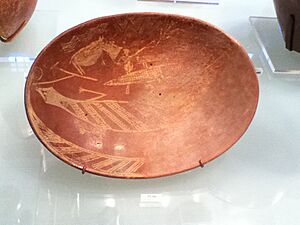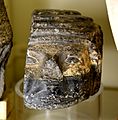Early Dynastic Period (Egypt) facts for kids
Quick facts for kids
Early Dynastic Period of Egypt
tȝwy
|
|||||||||||
|---|---|---|---|---|---|---|---|---|---|---|---|
| c. 3150 BC – c. 2686 BC | |||||||||||
 |
|||||||||||
| Capital | Memphis | ||||||||||
| Common languages | Ancient Egyptian | ||||||||||
| Religion | Ancient Egyptian religion | ||||||||||
| Government | Monarchy | ||||||||||
| Pharaoh | |||||||||||
|
• c. 3100 BC
|
Narmer (first) | ||||||||||
|
• c. 2690 BC
|
Khasekhemwy (last) | ||||||||||
| History | |||||||||||
|
• Established
|
c. 3150 BC | ||||||||||
|
• Disestablished
|
c. 2686 BC | ||||||||||
|
|||||||||||
| Today part of | |||||||||||
The Early Dynastic Period of Egypt was a time when Lower and Upper Egypt became one country. This happened around 3100 BC. People called this new united land the Two Lands.
During this period, the First and Second families of rulers (called dynasties) were in charge. This important time in history ended around 2686 BC. That's when the Old Kingdom began.
The capital city of Egypt moved from Thinis to Memphis. A powerful Egyptian god-king ruled the united country. Many important parts of ancient Egyptian life started to take shape then. This included their art, buildings, and religion.
Before this period, Egypt was made up of many small, separate villages. The new rulers created a government system for the whole country. Local royal governors helped run things. Early government buildings were often open-air temples. They were made from wood or sandstone. Writing, using hieroglyphs, started just before this period. We don't know much about the spoken language from that time.
Contents
How did Egyptian culture develop?
Around 3600 BC, early Egyptian societies lived along the River Nile. They began to grow crops and raise animals. Soon after, Egyptian society started to grow and change quickly. They made new styles of pottery and began using copper. Egyptians also started building with sun-dried bricks. They used arches and special walls for decoration.
How did Upper and Lower Egypt unite?
The societies and towns in Upper Egypt (along the upper Nile River) began to join together. The same thing happened in the Nile Delta, which was Lower Egypt. Often, there were wars between Upper and Lower Egypt.
During his rule in Upper Egypt, King Narmer defeated his enemies in the Delta. He united the Kingdoms of Upper and Lower Egypt under his rule. Pictures show Narmer wearing the double crown, called the Pschent. This crown had the lotus flower for Upper Egypt and the papyrus reed for Lower Egypt. These symbols of a united Egypt were used by all future rulers.
In mythology, the falcon-god Horus of Lower Egypt won a battle over the god Seth of Upper Egypt. This story helped create the idea that Egyptian kings were gods. This belief lasted for 3,000 years and was key to Egypt's government. The joining of Nile societies may also be linked to the drying of the Sahara Desert.
What changed in daily life?
Wealthy people started to have more complex funeral practices. Egyptians began building mastabas. These were flat-topped, rectangular tombs. They became models for later buildings, like the Step pyramid of the Old Kingdom. Growing cereal crops and organizing farm workers helped the state succeed for the next 800 years.
Egypt was likely united in its culture and economy before its first king ruled from Memphis. Political unification was a slow process, taking over a century. Local areas started trading with each other. Governments could organize large groups of farm workers. The idea of a divine king became more important. This happened as the cults of gods like Horus, Seth, and Neith spread across the country.
The Egyptian writing system also developed further. At first, Egyptian writing had a few symbols showing amounts of items. By the end of the third dynasty, it had grown to over 200 symbols. These included both phonograms (symbols for sounds) and ideograms (symbols for ideas).
Who was the First Pharaoh?
Manetho, an early Egyptian historian, said Menes was the first king of the Two Lands. Menes is probably Narmer. Narmer is the earliest recorded king of the First Dynasty. His name is on the king lists of Den and Qa'a. The kings of the First Dynasty saw Narmer as an important founder.
Narmer is also the earliest king linked to the symbols of power over the two lands. The Narmer Palette, a special cosmetic palette used for rituals, shows him wearing the Pschent. This is the double crown of Upper and Lower Egypt. Another idea is that Narmer was the last king of the Protodynastic Period. In this theory, Menes was Hor-Aha.
Images for kids
See also
 In Spanish: Periodo arcaico de Egipto para niños
In Spanish: Periodo arcaico de Egipto para niños





